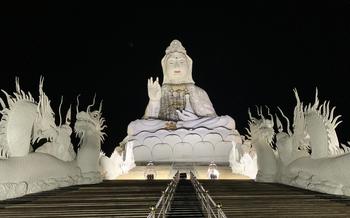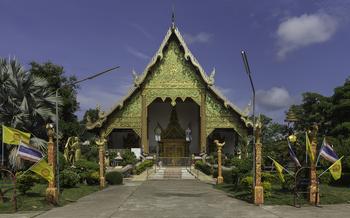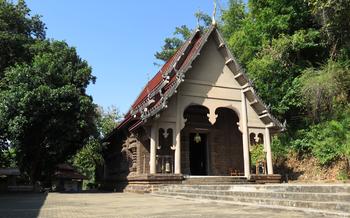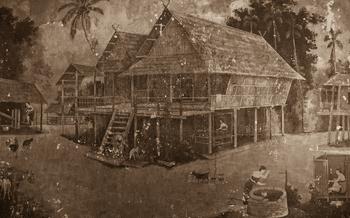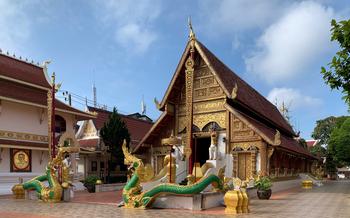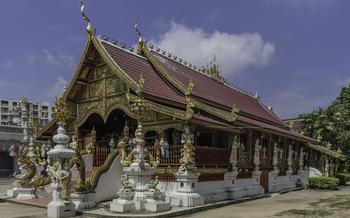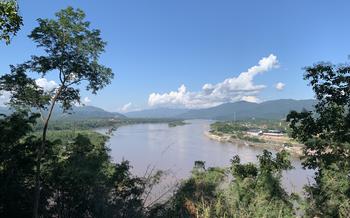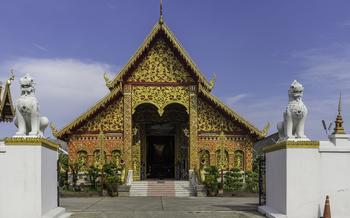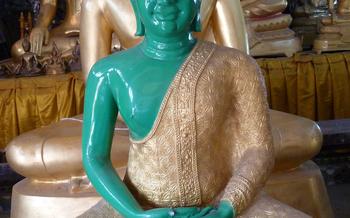
Wat Phrathat Mae Yen
- Exploring the Temple Grounds
- Paying Respects to the Buddha
- Taking in the Panoramic Views
- Learning About the Temple's History
- Participating in Temple Festivals
- Visiting the Nearby Village of Mae Yen
- Hiking in the Surrounding Mountains
- Visiting Other Temples in Chiang Rai
- Getting the Most Out of Your Visit
- Photography Tips
- Cultural Etiquette
- Insider Tip: The Secret Path
Exploring the Temple Grounds
The main temple building at Wat Phrathat Mae Yen is a stunning example of Lanna architecture, with its intricate carvings, colorful murals, and gleaming golden stupas. The interior of the temple is just as impressive, with its many Buddha images, elaborate altars, and beautiful paintings.
Surrounding the main temple building are several smaller stupas, each with its own unique design and significance. Some of the stupas are said to contain relics of the Buddha, while others are dedicated to various deities or historical figures.
The temple also has an ordination hall, where young men are ordained as Buddhist monks. The ordination hall is a beautiful building with a distinctive curved roof and intricate carvings. It is one of the most important buildings in the temple complex, and it is often used for special ceremonies and events.
In addition to the main temple building, the ordination hall, and the stupas, Wat Phrathat Mae Yen also has a number of other temple structures, including a library, a museum, and a meditation center. The temple grounds are also home to a variety of trees, flowers, and other plants, which add to the beauty and serenity of the surroundings.
Paying Respects to the Buddha
When visiting Wat Phrathat Mae Yen, it is essential to show respect for the Buddha and the temple grounds. This includes adhering to proper etiquette and customs.
Etiquette and Customs:
-
Dress Code: When entering the temple grounds, dress modestly and respectfully. Avoid wearing shorts, tank tops, or revealing clothing.
-
Footwear: Remove your shoes before entering the temple buildings. There will be designated areas where you can leave your footwear.
-
Behavior: Be mindful of your behavior and maintain a respectful demeanor. Avoid loud talking, laughing, or engaging in disruptive activities.
-
Offerings: Devotees offer various items to the Buddha, including flowers, incense, candles, and food. These offerings symbolize gratitude, respect, and merit-making.
Making Offerings:
-
Flowers: Place fresh flowers in the designated vases or containers near the Buddha images.
-
Incense: Light incense sticks and place them in the incense burners provided.
-
Candles: Light candles and place them in the designated holders.
-
Food: Offer food items such as fruit, sweets, or vegetarian dishes to the Buddha. These offerings are later shared among the monks and community.
Meditation and Reflection:
-
Meditation: Take some time to sit in meditation and reflect on the teachings of the Buddha.
-
Reflection: Use this opportunity to contemplate your own life, cultivate inner peace, and seek spiritual guidance.
Taking in the Panoramic Views
Wat Phrathat Mae Yen is renowned for its breathtaking panoramic views of the surrounding mountains and valleys. The temple is situated on a hilltop, offering visitors an unparalleled perspective of the region's stunning natural beauty. The best time to visit the temple for the most dramatic views is during the early morning hours, when the air is clear and the sun casts a golden glow over the landscape.
For the most rewarding experience, bring a packed lunch and enjoy a picnic on the temple grounds, savoring the delicious flavors of local cuisine while taking in the breathtaking scenery. Capture the moment with your camera, but be sure to follow the temple's rules and regulations regarding photography. Share your stunning photos with friends and family, inspiring them to embark on their own pilgrimage to this sacred mountaintop temple.
Learning About the Temple's History
Wat Phrathat Mae Yen has a rich and fascinating history that dates back to the 13th century. According to legend, the temple was founded by a monk named Nang Sao Waan, who was searching for a place to build a temple to honor the Buddha. After a long journey, Nang Sao Waan came to the Mae Yen Valley and was struck by the beauty of the landscape. He decided to build the temple on a hilltop overlooking the valley, where it would be a place of peace and tranquility.
Over the centuries, Wat Phrathat Mae Yen has undergone several renovations and additions. In the 16th century, the temple was expanded to include a large ordination hall and several stupas. In the 19th century, the temple was renovated and the main temple building was rebuilt in the Lanna style. The temple has also been damaged and rebuilt several times over the years, most recently in the 1970s when it was damaged by an earthquake.
Today, Wat Phrathat Mae Yen is a popular pilgrimage site for Buddhists from all over Thailand. The temple is also a popular tourist destination, and visitors come from all over the world to admire its beautiful architecture and stunning views.
Participating in Temple Festivals
Wat Phrathat Mae Yen is not just a place of pilgrimage and worship; it also hosts several festivals throughout the year, each with its own unique significance and celebration. These festivals are a wonderful opportunity to immerse yourself in the local culture and experience the temple's vibrant atmosphere.
One of the most important festivals is the Mae Yen Temple Fair, which takes place annually in February or March. This festival honors the temple's founding legend and features a variety of activities, including traditional Thai dance performances, music, food stalls, and a colorful procession carrying the temple's sacred Buddha image.
Another popular festival is Visakha Bucha, which commemorates the birth, enlightenment, and death of the Buddha. This festival is celebrated in May and typically involves chanting, meditation, and the release of sky lanterns.
If you're lucky enough to visit during one of these festivals, be sure to take part in the festivities and soak up the lively atmosphere. Remember to dress respectfully and observe local customs and traditions. Participating in a temple festival is a truly unforgettable experience that will give you a deeper appreciation for Thai culture and Buddhism.
Visiting the Nearby Village of Mae Yen
Just a stone's throw from the spiritual serenity of Wat Phrathat Mae Yen lies the charming village of Mae Yen, a treasure trove of authentic experiences that beckon you to immerse yourself in the heart of rural Thailand. As you step into this tranquil haven, you'll be greeted by the warm smiles of friendly locals who are eager to share their rich culture and way of life.
Mae Yen is a place where time seems to slow down, where the simplicity of life takes center stage, and where the community's deep connection to the land and its traditions is palpable. Take a leisurely stroll through the village, and you'll discover a treasure trove of hidden gems, from quaint shops selling handmade crafts to family-run restaurants serving up mouthwatering local delicacies.
Engage in conversation with the locals, and you'll learn about their fascinating stories, their age-old customs, and their deep-rooted beliefs. They'll share tales of the temple's history, the significance of the surrounding mountains, and the importance of preserving their unique way of life.
For a truly immersive experience, consider staying overnight in a local homestay. This is an exceptional opportunity to connect with a Thai family, learn about their daily routines, and gain a deeper understanding of Thai culture. You'll be welcomed into their home with open arms, treated to delicious home-cooked meals, and given a glimpse into the rhythms of life in rural Thailand.
Mae Yen is a place where you can truly escape the hustle and bustle of modern life and reconnect with the simple pleasures. Whether you're exploring the village's hidden gems, savoring the flavors of local cuisine, or simply relaxing in the company of friendly locals, you'll leave Mae Yen with a heart full of memories and a newfound appreciation for the beauty of rural Thailand.
Hiking in the Surrounding Mountains
Wat Phrathat Mae Yen is surrounded by stunning natural scenery, and there are many hiking trails that start from the temple grounds. These trails offer a great opportunity to explore the area and get some exercise at the same time.
Some of the trails are relatively easy, making them suitable for hikers of all fitness levels. Others are more challenging, offering a more strenuous workout. No matter what your fitness level, you're sure to find a trail that's right for you.
Along the trails, you'll see a variety of plants and animals. Keep an eye out for birds, monkeys, and other wildlife. You may also see some interesting rock formations and waterfalls.
If you're planning on hiking, be sure to wear comfortable shoes and clothing. You should also bring plenty of water and sunscreen. And don't forget your camera!
Hiking in the surrounding mountains is a great way to get some exercise, enjoy the fresh air, and see some stunning scenery. It's a perfect activity for anyone who loves the outdoors.
Visiting Other Temples in Chiang Rai
In addition to Wat Phrathat Mae Yen, Chiang Rai is home to a wealth of other beautiful and historic temples that are well worth exploring. Here are just a few of the many temples that you can visit during your stay in Chiang Rai:
-
Wat Rong Khun (White Temple): This stunning temple is one of the most popular tourist attractions in Chiang Rai. It is known for its unique and intricate white architecture, which is adorned with mirrors and glass.
-
Wat Phra Kaew (Temple of the Emerald Buddha): This temple is home to a replica of the Emerald Buddha, which is the most sacred Buddha image in Thailand. The temple is located in the heart of Chiang Rai city and is a popular pilgrimage site for Buddhists from all over the world.
-
Wat Doi Tong (Temple on the Mountain): This temple is located on a hilltop overlooking Chiang Rai city. It offers stunning views of the surrounding countryside and is a popular spot for sunset watching.
-
Wat Saen Mueang Ma (Temple of the 300 Buddhas): This temple is home to over 300 Buddha images, which are arranged in rows on the temple grounds. It is a popular spot for meditation and reflection.
When temple-hopping in Chiang Rai, it is important to dress respectfully. This means wearing long pants or a skirt that covers your knees, and a shirt that covers your shoulders. You should also remove your shoes before entering the temple grounds.
Getting the Most Out of Your Visit
To make the most of your visit to Wat Phrathat Mae Yen, it's essential to plan and prepare. The best time to visit is during the dry season, from November to April, when the weather is pleasant, and the skies are clear for unobstructed views. Avoid visiting during the Songkran festival in April, as the temple is crowded with pilgrims and tourists.
Before you go, dress respectfully in long pants or a skirt that covers your knees, and a shirt that covers your shoulders. You'll need to remove your shoes before entering the temple grounds, so wear comfortable footwear that's easy to take off and put on. Bring a hat, sunglasses, and sunscreen to protect yourself from the sun, as there's little shade on the temple grounds.
Remember that this is a sacred place of worship, so be respectful of the monks and other visitors. Keep your voice down, and avoid talking or laughing loudly. If you want to take photos, ask permission first, and be mindful of others who may be praying or meditating.
If you're planning to hike in the surrounding mountains, let someone know where you're going and when you expect to be back. Bring plenty of water, snacks, and a first-aid kit, and be prepared for changing weather conditions. It's also a good idea to wear sturdy hiking shoes and long pants to protect yourself from insects and thorns.
Photography Tips
It is imperative to equip yourself with the appropriate camera settings to capture the temple's allure in your photographs. Utilize a wide-angle lens to encompass the temple's grandeur. To achieve sharp and well-defined shots, mount your camera on a tripod. Experiment with different shutter speeds to capture the movement of the clouds and the surrounding foliage.
Pay heed to the temple's rules and regulations regarding photography. Refrain from using flash photography, as it can be disruptive to other visitors and damaging to the temple's interior. Be mindful of the lighting conditions, as the temple's appearance can vary dramatically throughout the day.
Share your captured memories with the world and inspire others to embark on their own pilgrimage to Wat Phrathat Mae Yen. Utilize social media platforms to showcase your stunning photographs and narrate your unique experiences. By sharing your journey, you contribute to the preservation and appreciation of this sacred site.
Cultural Etiquette
It is imperative to dress respectfully when visiting Wat Phrathat Mae Yen. Revealing or skimpy clothing is not appropriate, and shoulders and knees should be covered. When entering the temple grounds, it is customary to remove your shoes and leave them in the designated area. This is a sign of respect for the sacredness of the space.
When interacting with monks and other visitors, it is important to be polite and respectful. Avoid loud noises and boisterous behavior, and refrain from touching or pointing at the monks. If you have any questions, it is best to ask a temple staff member or a local guide.
It is also important to be mindful of your noise level. The temple is a place of peace and tranquility, and loud talking or laughing can be disruptive to other visitors. If you need to have a conversation, please do so in a quiet voice or step outside of the temple grounds.
By following these simple guidelines, you can show your respect for the temple and its visitors and ensure that everyone has a peaceful and enjoyable experience.
Insider Tip: The Secret Path
In addition to the main hiking trails, there is a hidden path that leads to a secluded viewpoint. This path is not well-known and requires some effort to find, but it is well worth the effort for the stunning views that it offers.
To find the path, look for a small sign that says "Viewpoint" near the back of the temple grounds. Follow the sign and you will find a narrow path that leads into the forest. The path is steep and rocky in places, so be sure to wear sturdy shoes.
After a short hike, you will reach a clearing with a small pavilion. This is the viewpoint. From here, you can enjoy panoramic views of the surrounding mountains and valleys. The views are especially stunning at sunrise and sunset.
Please be respectful of the temple's rules and regulations regarding the path. Do not litter and be mindful of your noise level. The path is meant to be a place of peace and tranquility.
If you are looking for a unique and rewarding experience, I highly recommend exploring the secret path at Wat Phrathat Mae Yen. It is a great way to get away from the crowds and enjoy the natural beauty of the area.

